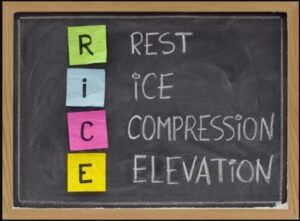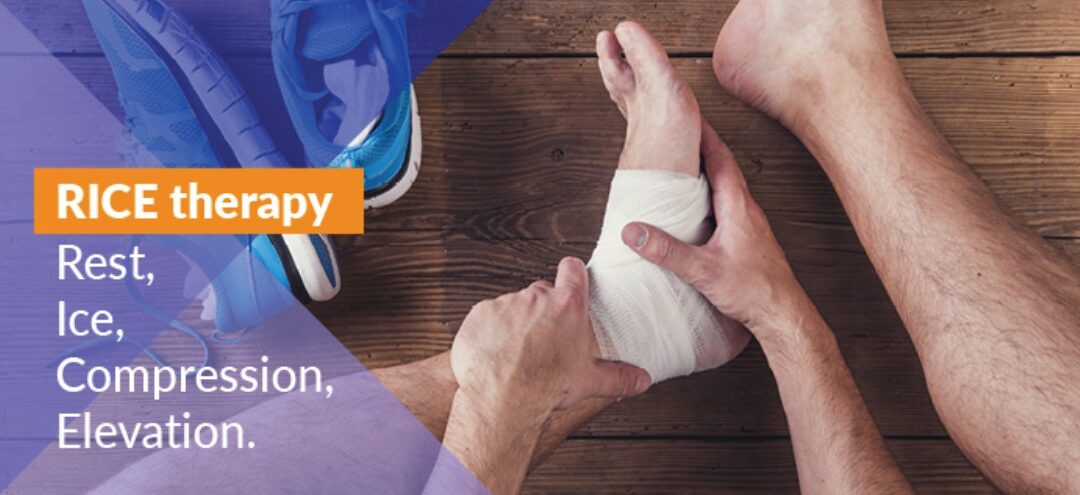Is the acronym ‘R.I.C.E’ outdated?
For many years when presented with any acute soft tissue injury such a sprained ankle, or muscle tear, the immediate go to method was R.I.C.E. This concept goes way back to 1978 when Dr. Gabe Mirkin an American sports doctor came up with the term. Even today some people are still using R.I.C.E to treat sports injuries or everyday musculoskeletal injuries.
The letters stood for:

Over time and with further scientific investigations, it has come to be known that R.I.C.E is outdated and that it is not the most effective way to manage acute soft tissue injuries.
Even Dr. Mirkin himself decided to update it in 2015. The scientific debate on this protocol is huge and continues to this day.
So, what came next?
R.I.C.E.R which is the same as above except the last letter ‘R’ stands for ‘Referral’. This would prompt someone to refer the injured person to a qualified professional such as a doctor or a physiotherapist for a precise diagnosis, ongoing care, and treatment. The Physiotherapists at Power Physiotherapy are highly skilled and experienced at treating all acute musculoskeletal injuries. We encourage people to attend ASAP after an injury (preferably on day one), to be given the correct advice to assist healing and recovery.
But was R.I.C.E.R enough? Were we still not looking at the bigger picture on the care of acute injuries.
Further scientific research progressed over the years, which stirred a big debate on the concept of rest and the use of ice. The questions being asked included: ‘was rest and the use of ice helpful or harmful to recovery?’ (The topic on the use of ice will be saved for another day as this topic is huge by itself.)
It started to unfold that complete rest as suggested by R.I.C.E and R.I.C.E.R was not the appropriate approach with any acute soft tissue injury (sprain or strain), sporting injury, or musculoskeletal injury. Complete rest could lead to several things including deconditioning of the muscles, stiffness of the joints, prolonged pain, and increased risk of reoccurring injuries.
So, a new acronym began called P.O.L.I.C.E which stood for:

Now we were heading in a better direction in the care of these injuries. The concept of complete rest was no longer relevant, but researchers identified that ‘modified rest’, (moving within comfortable limits), while still protecting a joint or muscle was vital in the first few days. This protection could include the use of a walking aid, strapping, bandaging, so moving while causing minimal discomfort.
Optimal Loading further highlighted the importance of moving or exercising within the limits that would allow optimal healing. This meant starting with simple movements, then gradually progressing from non-weight bearing to weight bearing, or even gradually introducing a weight. At Power Physiotherapy we always instruct our patients that they must listen to their bodies, identify their level of pain, and only move or exercise with mild discomfort. Anything more than mild discomfort would indicate working above the optimal load for that injury at that point in time.
The key with optimal loading is that it stimulates the healing process of bones, tendons, ligaments, and muscles. Complete rest does not encourage or promote this healing.
In 2019, Blaise Dubois and Jean-Francois Esculier, two Physical Therapists from Canada published a paper in the British Journal of Sports Medicine introducing two new acronyms:

These stand for:
P: Protection
E: Elevation
A: Avoid anti-inflammatories
C: Compression
E: Education
AND
L: Load
O: Optimism
V: Vascularisation
E: Exercise.
As you can see the progression of concepts over time have changed the way soft tissue injuries, particularly acute sprains and strains are managed, especially in the first 24 – 48 hours.
So, what should you do if you or a family member experience a soft tissue injury? This may occur while at the gym, or on the sporting field or even tripping over the cat. There is nothing wrong with starting with the traditional R.I.C.E concept, especially if you don’t know what to do. However, it is vital that you attend a consult with a health professional to diagnose the injury and head you in the right direction of care.
You can count on us at Power Physiotherapy to do exactly that for you. On the first visit we do a full assessment of the injury, we give you a diagnosis, we commence the appropriate treatment, then provide you with a time frame of recovery. If you need further investigations such as an x-ray or a scan, we will advise you to do so. In addition, if we feel you need to see a doctor to get a referral to a specialist, we can advise you on that also. The time to look after your injury is day one.




